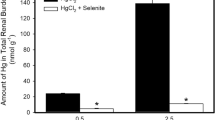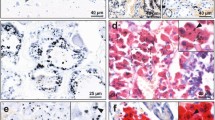Abstract
Three groups of female monkeys (Macaca fascicularies) were exposed to methylmercury (MeHg, p.o. 50 μg Hg/kg body wt per day) for 6, 12, or 18 months. One group was exposed to MeHg for 12 months and kept unexposed for 6 months before sacrifice. Another group of three monkeys was exposed to HgCl2 i.v. for 3 months. Total and inorganic mercury concentrations in occipital pole and thalamus were determined by cold vapor atomic absorption spectroscopy. Selenium concentrations were analyzed by hydride generation atomic absorption spectroscopy. The results indicated an association between concentrations of inorganic mercury and selenium in both occipital pole and thalamus in the MeHg-exposed animals. A linear regression model using concentrations of inorganic mercury (nmol/g wet wt) as independent variable, and selenium concentrations (nmol/g wet wt) as the dependent variable showed significant correlations between the variables in both occipital pole and thalamus (r=0.85 and r=0.91, P<0.0001). The intercept of the regression line was slightly lower (about 2 nmol Se/g wet wt) than the selenium concentrations found in control monkeys (about 3 nmol Se/g wet wt). There was a tendency to a “hockey stick”-shaped relationship between concentrations of selenium and inorganic mercury in the thalamus of monkeys with ongoing exposure to MeHg. An important role for selenium in the retention of mercury in brain is indicated.
Similar content being viewed by others
References
Behne D, Hilmert H, Scheid S, Gessner H, Elger W (1988) Evidence for specific selenium target tissues and new biologically important selenoproteins. Biochim Biophys Acta 966: 12–21
Behne D, Kyriakopoulos A, Meinhold H, Köhrle J (1990) Identification of type I iodothyronine 5′-deiodinase as a selenoenzyme. Biochem Biophys Res Commun 173: 1143–1149
Berlin M (1986) Mercury. In: Friberg L, Nordberg GF, Vouk VB (eds) Hanbook on the toxicology of metals, 2nd edition, vol. II: Specific metals. Elsevier, Amsterdam, pp 387–445
Björkman L, Palm B, Nylander M, Nordberg M (1994) Mercury and selenium distribution in human kidney cortex. Biol Trace Elem Res 40: 255–265
Brzeznicka EA, Chmielnicka J (1985) Interaction of alkylmercuric compounds with sodium selenite. III. Biotransformation, levels of metallothioneinlike proteins and endogenous copper in some tissues of rats exposed to methyl or ethylmercuric chloride with and without sodium selenite. Environ Health Perspect 60: 423–431
Chen RW, Lacy VL, Whanger PD (1975) Effect of selenium on methylmercury binding to subcellular and soluble proteins in rat tissues. Res Commun Chem Pathol Pharmacol 12: 297–308
Combs GF (1993) Essentiality and toxicity of selenium with respect to recommended dietary allowances and reference doses. Scand J Work Environ Health 19 [Suppl 1]: 119–121.
Ganther HE, Goudie C, Sunde ML, Kopecky MJ, Wagner P, Oh SH, Hoekstra WG (1972) Selenium: relation to decreased toxicity of methylmercury added to diets containing tuna. Science 175: 1122–1124
Hansen JC (1988) Has selenium a beneficial role in human exposure to inorganic mercury? Med Hypoth 25: 45–53
Hargreaves RJ, Evans JG, Janota I, Magos L, Cavanagh JB (1988) Persistent mercury in nerve cells 16 years after metallic mercury poisoning. Neuropathol Appl Neurobiol 14: 443–452
Iwata H, Masukawa T, Kito H, Hayashi M (1982) Degradation of mercury by selenium. Life Sci 31: 859–66
Koeman JH, van de Ven WSM, de Goeij JJM, Tjioe PS, van Haaften JL (1975) Mercury and selenium in marine mammals and birds. Sci Total Environ 3: 279–287
Kosta L, Byrne AR, Zelenko V (1975) Correlation between selenium and mercury in man following exposure to inorganic mercury. Nature 254: 238–239
Leonzio C, Focardi S, Fossi C (1992) Heavy metals and selenium in stranded dolphins of the Northern Tyeehenian (NW Mediterranean). Sci Total Environ 119: 77–84
Lind B, Friberg L, Nylander M (1988) Preliminary studies on methylmercury biotransformation and clearance in the brain of primates: II Demethylation of mercury in brain. J Trace Elements Exp Med 1: 49–56
Lind B, Body R, Friberg L (1993) Mercury speciation in blood and brain tissue from monkeys. Interlaboratory comparison of Magos method with other spectroscopic methods, using alkylation and gas chromatography separation as well as RNAA in combination with Westöö’s extraction methods. Fres J Anal Chem 345: 314–317
Lind B, Holmgren E, Friberg L, Vahter M (1994) Demethylation of methylmercury during inorganic mercury determination by the Magos cold vapor atomic absorption technique. Fres J Anal Chem 348: 815–819
Magos L (1971) Selective atomic-absorption determination of inorganic mercury and methylmercury in undigested biological samples. Analyst 96: 847–852
Magos L, Webb M (1977) The effect of selenium on the brain uptake of methylmercury. Arch Toxicol 38: 201–207
Magos L, Webb M (1980) The interactions of selenium with cadmium and mercury. Crit Rev Toxicol 8: 1–42
Magos L, Webb M, Hudson AR (1979) Complex formation between selenium and methylmercury. Chem-Biol Interact 28: 359–362
Magos L, Clarkson TW, Hudson AR (1984) Differences in the effects of selenite and biological selenium on the chemical form and distribution of mercury after the simultaneous administration of HgCl2 and selenium to rats. J Pharmacol Exp Ther 228: 478–483
Naganuma A, Satoh H, Yamamoto R, Suzuki T, Imura N (1979) Effect of selenium on determination of mercury in animal tissues. Anal Biochem 98: 287–292
Nylander M, Weiner J (1991) Mercury and selenium concentrations and their interrelations in organs from dental staff and the general population. Br J Ind Med 48: 729–734
Nylander M, Burbacher T, Friberg L, Lind B, Mottet K, Vahter M (1990) Inorganic mercury and selenium in the brain of monkeys exposed to methylmercury. In: Nylander M (ed) Accumulation and biotransformation of mercury and its relationship to selenium after exposure to inorganic mercury and methyl mercury. A study on individuals with amalgam fillings, dental personnel, and monkeys. Thesis, Karolinska Institutet, Stockholm
Parizek J, Ostadalova I (1967) The protective effect of small amounts of selenite in sublimate intoxication. Experientia 23: 142–143
Prohaska JR, Ganther HE (1977) Interactions between selenium and methylmercury in rat brain. Chem-Biol Interact 16: 155–167
Rotruck JT, Pope AL, Ganther HE, Swanson AB, Hafeman DG, Hoekstra WG (1973) Selenium: biochemical role as a component of glutathione peroxidase. Science 179: 588–590
Vahter M, Mottet NK, Friberg L, Lind B, Shen DD, Burbacher T (1994) Speciation of mercury in the primate blood and brain following long-term exposure to methylmercury. Toxicol Appl Pharmacol 124: 221–229
WHO (1987) Environmental Health Criteria 58: Selenium World Health Organization, Geneva
Yamamoto R, Satoh H, Suzuki T, Naganuma A, Imura N (1980) The applicable condition of Magos’ method for mercury measurement under coexistence of selenium. Anal Biochem 101: 254–259
Yamane Y, Fukino H, Aida Y, Imagawa M (1977) Studies on the mechanism of protective effects of selenium against the toxicity of methylmercury. Chem Pharmacol Bull 25: 2831–2837
Author information
Authors and Affiliations
Rights and permissions
About this article
Cite this article
Björkman, L., Mottet, K., Nylander, M. et al. Selenium concentrations in brain after exposure to methylmercury: relations between the inorganic mercury fraction and selenium. Arch Toxicol 69, 228–234 (1995). https://doi.org/10.1007/s002040050163
Received:
Accepted:
Issue Date:
DOI: https://doi.org/10.1007/s002040050163




